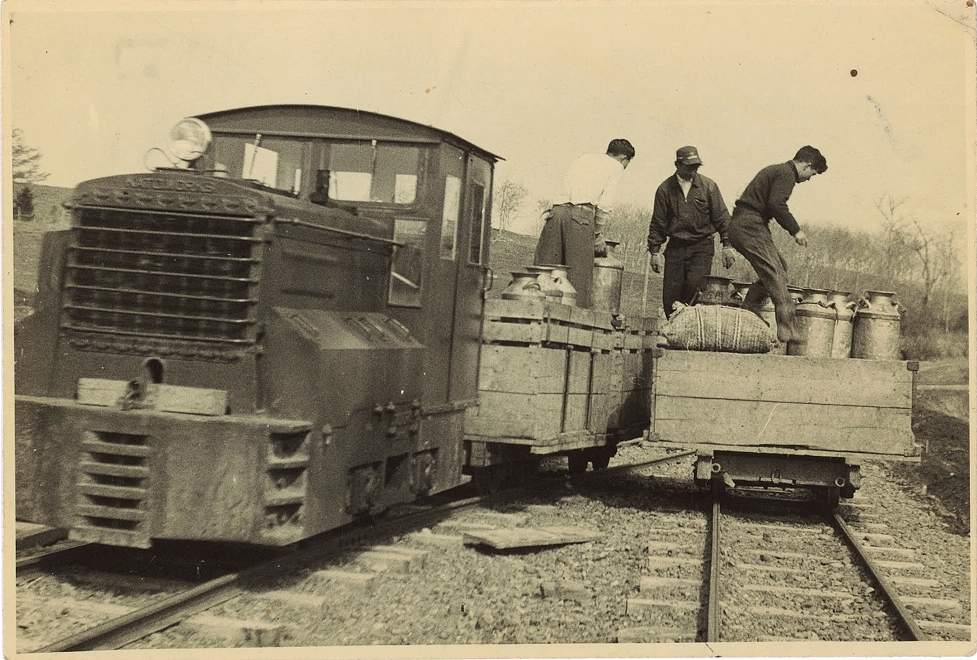
Reloading milk cans on the Chanai Line (about 1956, property of Inoue Sakio)

Reloading milk cans on the Chanai Line (about 1956, property of Inoue Sakio)
From the 1860s to the first decade of the nineteenth century, migration to Hokkaido was actively promoted but did not take root because transportation in the newly settled region was inconvenient.
To solve this problem the Hokkaido Agency planned the construction of the Colonial Railway. Its track gauge was 762 mm which was narrower than the present JR gauge of 1,067 mm, reducing the cost of both its construction and maintenance. The national government constructed and maintained the tracks and other facilities. In the beginning the trains were horse-drawn and operated by local operating associations. This railway ensured more dependable transportation than that possible on the roads which at that time, were made by simply consolidating the ground.
In December 1924, the first line, a 48.8 km track from Atokko Station to Nakashibetsu on the Nemuro Main Line was completed. A large-scale opening ceremony was held at Atokko.

Opening ceremony held on the Attoko Station Plaza (Postcard/property of Miyake Toshihiko)
The full-scale construction of the Colonial Railway started in 1927. It included a total of 805 kilometers of track on 47 lines throughout Hokkaido. It was a successful mode of transportation indispensable for the colonists, particularly in Eastern and Northern Hokkaido.
Horse-drawn transport was inadequate to support the task of opening up the region, so in 1929, gasoline powered locomotives were introduced from Attoko to Nakashibetsu on the Nemuro Line, and lines on which the transport volumes soared were transformed into full-scale railway lines.
The Colonial Railway not only carried passengers, its trains transported charcoal and lumber and supported dairying which the sources of the incomes of the pioneering farm families.


Railway network in the Kushiro and Nemuro regions in 1932 (top) and 1943 (bottom)
After the war, the Colonial Railway was renamed the Agricultural Light Railway. By the 1950s, many lines that could be converted to roads were abandoned, while lines carrying large volumes of cargo were motorized and reconstructed. Diesel cars were introduced and staffed by uniformed female conductors.

Diesel Car (about 1956, property of Tsurui Village Office)
As a result of the rapid introduction of paving beginning in the late 1960s, road transportation improved greatly and the Agricultural Light Railway lost its role. In the late 1960s and early 1970s many lines closed: the Setsuri Line in 1967, the Shibecha Line and Furen Line, the Toikanbetsu Line and Utanobori Line in 1971, then in 1972, the Chanai Line and Wakamatsu Line which played the most important role in transporting milk. In this way, the Agricultural Light Railway that had supported the opening up of Hokkaido for about half a century vanished.

Final run on the Chanai and Wakamatsu Lines (property of Sejimo Koki)
The Kushiro City Museum began a thorough survey of the Agricultural Light Railway in 2014. With the cooperation of towns and villages served by lines which survived until its last years, researchers interviewed men and women who were formerly employed by the railway and others who had used it. They also collected photographs, voice recordings, moving pictures and gathered information from railway lovers who had witnessed the Agricultural Light Railway in operation. The dates and places where many of these records were created were clarified, making them valuable sources of information.
As a special exhibition to commemorate its eightieth anniversary, the Kushiro City Museum decided to hold the exhibition, Agricultural Light Railway in Kushiro and Nemuro in 2016. To stimulate interest in this exhibition, it was preceded by lectures given by researchers and tours to see a diesel car preserved in operating condition. The exhibition was held from fall to winter of 2016, attracting many visitors from both inside and outside of Hokkaido. In 2017, to celebrate the eightieth anniversary of the opening of the NHK Kushiro Station, the museum jointly held the exhibition, History of the Agricultural Light Railway and Opening of Hokkaido Revived in Moving Pictures. Then in November 2018, it opened the permanent Kushiro-Nemuro Agricultural Light Railway Corner to function as a central source of information about this railway system.

Exhibition jointly held with the NHK Kushiro Station
In 2018, the Agricultural Light Railway of Hokkaido was designated a Hokkaido Heritage.
If you wish to see the Agricultural Light Railway up close, we urge you to visit the Furusato-Johokan (Public Library) in Tsurui Village and see the railway cars preserved on the site of the former Okuyukiusu Station in Betsukai Town. You can even visit Tsurui in the winter to study the history of the village in its library. At Okuyukiusu, not only the Agricultural Light Railway, but the adjoining post station and JR Station are preserved, so it is a place that can be described as sacred ground in the history of transportation in Hokkaido. Here, this small railway that ceased to exist a half century ago is recovering its past glory.

Diesel car on the Chanai Line (Photo by Yusa Yo in 1971)